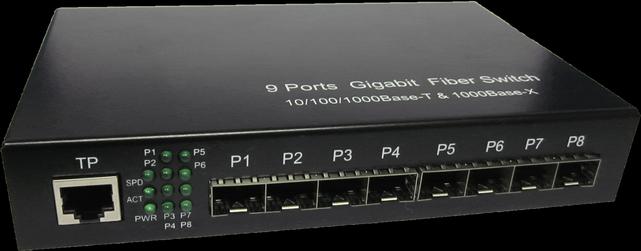Introduction
Users can choose all-optical port configuration or optical-electrical port hybrid configuration, and access to optical fiber media can be single-mode fiber or multi-mode fiber. The switch can support network remote management and local management at the same time to realize the monitoring of port working status and switch settings.
Optical fiber port is particularly suitable for the information point access distance beyond the access distance of Category 5 lines, the need for anti-electromagnetic interference and the need for communication confidentiality, etc. The applicable fields include: residential quarters FTTH broadband access network; enterprise high-speed Optical fiber local area network; high-reliability industrial distributed control system (DCS); optical fiber digital video surveillance network; hospital high-speed optical fiber local area network; campus network.
Product performance
Non-blocking store-and-forward switching mode, with 5.2Gbps switching capacity, all ports can work at full-duplex at full wire speed at the same time
Support 6K MAC addresses, with automatic MAC address learning and update functions
Support port aggregation, provide 7 groups of aggregated broadband trunk roads
Support priority queues, provide service quality assurance< /p>
Support 802.1d Spanning Tree Protocol/Rapid Spanning Tree Protocol
Support 802.1x port-based access authentication
Support IEEE802.3x full-duplex flow control/half Duplex back pressure flow control
Support tag-based VLAN/port-based VLAN/protocol-based VLAN, providing 255 VLAN groups, up to 4K VLANs
Support Port-based network access control
With port isolation function
Support port and MAC address binding, MAC address filtering
With header blocking (HOL) prevention Mechanism to minimize packet loss
With SNIFF network monitoring function
Support port mirroring
With port bandwidth control function
Support IGMP snooping multicast control
Support broadcast storm control

Network management:
Remote centralized network management: support SNMP, based on Web Management, Telnet; based on designated ports or 802.1Q VLAN to increase security.
Local independent network management: through a standard RS-232 interface
Network standards and protocols:
IEEE:
802.3, 802.3u, 802.1d, 802.1p, 802.1q, 802.1v, 802.3ad, 802.3x, 802.1x
IEFT:
RFC1157 SNMP, RFC 1112 /2236 IGMP, RFC854 Telnet, RFC 1123/1493/1643 MIB
Operating wavelength and transmission distance of optical fiber port:
Single fiber single mode, dual wavelength 1550nm/1310nm, 20/40km
Dual fiber single mode, single wavelength 1310nm or 1550nm, 20/40/60km
Dual fiber multimode, single wavelength 1310nm, 2km
Power supply:
AC 176-264V/1.2A, 50/60Hz
DC 18-36V/2A
DC 36-72V/1.5A
Power consumption: 35W
Physical and environmental parameters:
Standard 19-inch rack Installation width, 1U high
Weight 4kg
Working temperature: 0℃-50℃
Storage temperature: -25℃—55℃
p>Relative humidity: 5%-95% non-condensing
